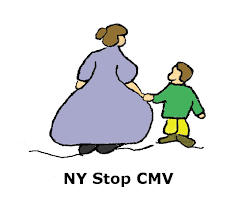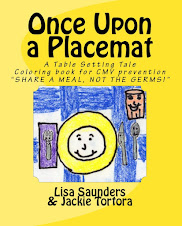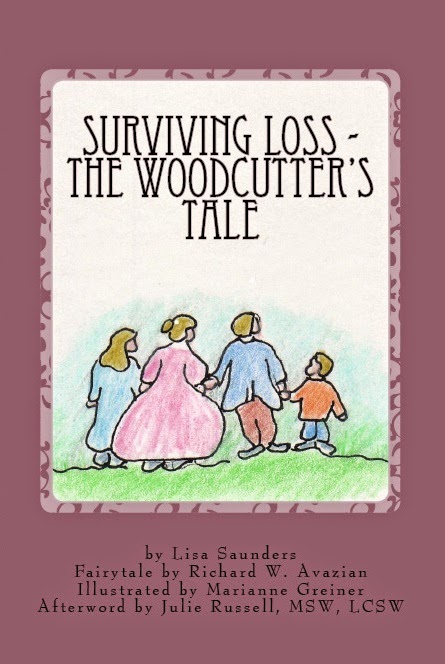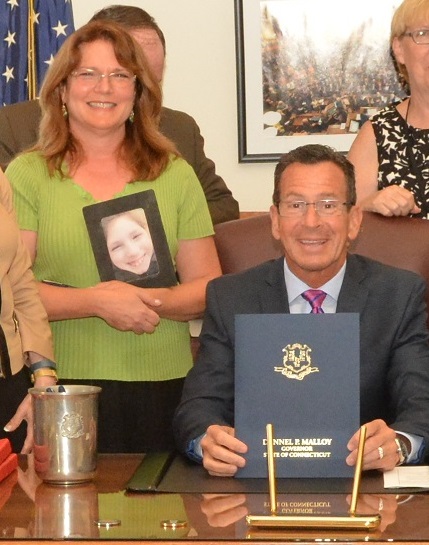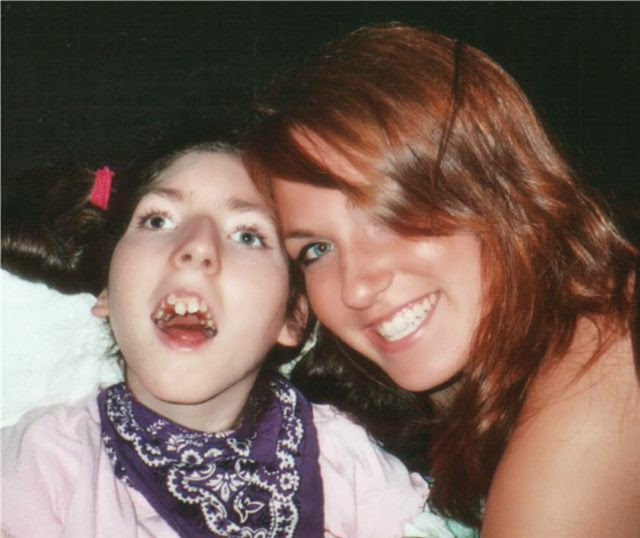I'm sure you are aware of the CMV "Hazard Recognition" by the Occupational Safety and Health Administration (OSHA) that states: "Childc
Lisa Saunders
CMV Education AdvocateBaldwinsville, NY (formerly of Mystic, CT)LisaSaunders42@gmail.comLisa's CMV-Related Resume
Facebook: https://www.facebook.com/congenitalcmvnews/
Facebook: https://www.facebook.com/congenitalcmvnews/
Learn more about Lisa's CMV work in Cornell Alumni Magazine's: In Memory of Elizabeth: Her daughter's death from a preventable disability spurs Lisa Avazian Saunders '82 into action (2015). Lisa was instrumental in helping Connecticut become the second state to pass a CMV testing law: "Mystic Mom 'Overwhelmed' by Governor Signing Law on ‘Stealth Virus’ That Can Catch Pregnant Women Unaware"(Erik Ofgang, Updated
Lisa is the author of:
CMV RESOURCES
FLYERS
Centers for Disease Control and Prevention (CDC):
“CMV Fact Sheet for Pregnant Women and Parents
English: https://www.cdc.gov/
Spanish: https://www.cdc.gov/
Utah has a great website with many downloadable resources for child care providers. See: CMV What Childcare Providers Need to Know (English) | Lo qué los proveedores de cuidado infantil necesitan saber sobre CMV (Spanish)
National CMV Foundation: Flyers on several CMV related topics at: https://www.nationalcmv.
One I recommend for classroom walls: “Are You Pregnant?”: https://www.
PRESENTATIONS
For Caregivers/Teachers/Educators: "CMV Training Module Video": https://aural.rehab.
For Employers:
There is now a free, online CMV presentation by Cornell University's Nellie Brown, MS, CIH, Certified Industrial Hygienist, and Director, Workplace Health and Safety Program, Worker Institute, Cornell University – ILR School. No fees or registration are required. Nellie Brown's email is in case you want to contact her about doing a live Q and A over Zoom. Nellie Brown’s presentation is available as the following:Publication: Brown, N. J. (2019, November). Occupational exposure to cytomegalovirus (CMV): Preventing exposure in child care and educational settings, including OSHA advisories. Ithaca, NY: Cornell University, ILR School. Available from: https://digitalcommons.
- Vimeo: https://vimeo.com/
- Download video workshop: https://vimeo.com/
MORE INFORMATION
NEVER HEARD OF CMV?
"There is more than one ‘C virus’ out there. It's called cytomegalovirus or CMV,” says Gail J. Demmler-Harrison, MD, Professor, Baylor College of Medicine. A pediatric infectious diseases expert with over 30 years experience and expertise in diagnosis and management of children with congenital CMV at Texas Children’s Hospital, Dr. Demmler-Harrison states: "Congenital CMV continues to be the most common congenital viral infection in this country, affecting thousands of babies each year, year after year, and it is a common cause of hearing loss, vision loss, and disabilities in our children." In her article,“CMV In Pregnancy: What Should I Know?”, she writes, “Approximately 1-4% of all pregnant women will experience a primary CMV infection during their pregnancy. If you work in a child care setting, the risk increases to approximately 10%. If you have a toddler at home who is actively infected with CMV and shedding CMV in their saliva or urine, the risk is even higher, approaching 50% in some studies” (Texas Children’s Hospital, 2014). (Watch/read her interview in the New York Times article, CMV Is a Greater Threat to Infants Than Zika, but Far Less Often.)
Centers for Disease Control and Prevention (CDC):
“CMV Fact Sheet for Pregnant Women and Parents
English: https://www.cdc.gov/
Spanish: https://www.cdc.gov/
Utah has a great website with many downloadable resources for child care providers. See: CMV What Childcare Providers Need to Know (English) | Lo qué los proveedores de cuidado infantil necesitan saber sobre CMV (Spanish)
National CMV Foundation: Flyers on several CMV related topics at: https://www.nationalcmv.
One I recommend for classroom walls: “Are You Pregnant?”: https://www.
PRESENTATIONS
For Caregivers/Teachers/Educators: "CMV Training Module Video": https://aural.rehab.
For Employers:
Publication: Brown, N. J. (2019, November). Occupational exposure to cytomegalovirus (CMV): Preventing exposure in child care and educational settings, including OSHA advisories. Ithaca, NY: Cornell University, ILR School. Available from: https://digitalcommons.
ilr.cornell.edu/conference/45/ - Vimeo: https://vimeo.com/
450219803 - Download video workshop: https://vimeo.com/
user43999427/download/ 450219803/e5b7be27db
MORE INFORMATION
NEVER HEARD OF CMV?
"There is more than one ‘C virus’ out there. It's called cytomegalovirus or CMV,” says Gail J. Demmler-Harrison, MD, Professor, Baylor College of Medicine. A pediatric infectious diseases expert with over 30 years experience and expertise in diagnosis and management of children with congenital CMV at Texas Children’s Hospital, Dr. Demmler-Harrison states: "Congenital CMV continues to be the most common congenital viral infection in this country, affecting thousands of babies each year, year after year, and it is a common cause of hearing loss, vision loss, and disabilities in our children." In her article,“CMV In Pregnancy: What Should I Know?”, she writes, “Approximately 1-4% of all pregnant women will experience a primary CMV infection during their pregnancy. If you work in a child care setting, the risk increases to approximately 10%. If you have a toddler at home who is actively infected with CMV and shedding CMV in their saliva or urine, the risk is even higher, approaching 50% in some studies” (Texas Children’s Hospital, 2014). (Watch/read her interview in the New York Times article, CMV Is a Greater Threat to Infants Than Zika, but Far Less Often.)
The Child Care and Development Block Grant Act of 2014 has created regulatory changes. The Administration for Children and Families published Caring for our Children Basics (based on Caring for Our Children) in 2015 to “align basic health and safety efforts across all early childhood settings." In the section, “Prevention of Exposure to Blood and Body Fluids,” it states: “Caregivers and teachers are required to be educated regarding Standard Precautions [developed by CDC] before beginning to work in the program and annually thereafter. For center-based care, training should comply with requirements of the Occupational Safety and Health Administration (OSHA).”
A suggested protocol for child centers includes:Acceptance of Occupational Risk by Staff Members: "Each staff member (paid or volunteer) is required to review with a supervisor the following acknowledgment of occupational risk and sign the statement to acknowledge and agree to accept the risk: “I understand there are health risks related to working in child care. These include, but are not limited to, exposure to infectious diseases (including infections that can damage a fetus during a pregnancy)..."
Model Child Care Health Policies (American Academy of Pediatrics, Pennsylvania Chapter, Aronson, SS, ed., 2014, p. 116). See: http://ecels-
Potential Cost of Not Warning Workers about CMV:
In New South Wales, “a childcare worker and her severely disabled son were awarded $4.65 million. A Court of Appeal ruled that the child's disabilities resulted from the woman being infected with cytomegalovirus (CMV) at work (Hughes v SDN Children's services 2002)” (Queensland Government, Australia, 2017). Meridian Lawyers of Australia stated: "The allegations of negligence were that Sydney Day Nursery breached its duty of care to Linda ...by failing to warn her of the risks of CMV in circumstances where the centre knew or ought to have known of the risks of CMV to pregnant women…" (Suggested policy of Meridian Lawyers of Australia found at: www.meridianlawyers.com.
Want to help your state's teachers/caregivers?
TO DO:
Contact your state’s childcare care licensing department, department of health, department of labor, and local universities with occupational medicine and public health programs. CMV is a bloodborne pathogen. Contact your state's health and child care licensing commissioner. Ask them to follow the recommendations made by the American Academy of Pediatrics and OSHA or work at getting your state to pass a law requiring CMV education.
If the policy makers need incentive to spend money on prevention education, consider this:
Annual cost of caring for children disabled cCMV by state: In 2018, 3,791,712 babies were born in U.S. with 1/200 born with cCMV x 1/5 disabled by cCMV= 3,792 babies disabled by cCMV in 2018. In New York in 2018, the annual cost of caring for children disabled by cCMV can be calculated at 226,238 births x .1% cCMV disabled = 226 babies X $300,000/year = $67,800,00 or over 67 million dollars to care for cCMV disabled children in New York in 2018.
The Child Care and Development Block Grant Act of 2014 has created regulatory changes. The Administration for Children and Families published Caring for our Children Basics (based on Caring for Our Children) in 2015 to “align basic health and safety efforts across all early childhood settings." In the section, “Prevention of Exposure to Blood and Body Fluids,” it states: “Caregivers and teachers are required to be educated regarding Standard Precautions [developed by CDC] before beginning to work in the program and annually thereafter. For center-based care, training should comply with requirements of the Occupational Safety and Health Administration (OSHA).”
Potential Cost of Not Warning Workers about CMV:
In New South Wales, “a childcare worker and her severely disabled son were awarded $4.65 million. A Court of Appeal ruled that the child's disabilities resulted from the woman being infected with cytomegalovirus (CMV) at work (Hughes v SDN Children's services 2002)” (Queensland Government, Australia, 2017). Meridian Lawyers of Australia stated: "The allegations of negligence were that Sydney Day Nursery breached its duty of care to Linda ...by failing to warn her of the risks of CMV in circumstances where the centre knew or ought to have known of the risks of CMV to pregnant women…" (Suggested policy of Meridian Lawyers of Australia found at: www.meridianlawyers.com.
BARRIERS TO GETTING LEGISLATION PASSED
· CMV is unknown: Since legislators have never heard of CMV, they think if it was a problem, OB/GYNs would say so.
SOLUTIONS
Streamline educating legislators: Create a one-page CMV fact sheet (click here for example) telling them what they quickly need to know to convince others. Provide a pocket folder that includes back-up documents such as the bills passed in other states (find them at www.nationalcmv.org/cmv-research/advocacy), the new CMV flyers from CDC: (Spanish/English), flyers/posters from the National CMV Foundation (so they see educational materials already exist), relevant newspaper articles and scientific studies.
Attract Media Attention: Give yourselves a name such as [your state name] CMV Advocacy Project. Create a Facebook page with your group name on it and complete the “About” section. Sent media releases to TV/radio/newspapers quoting doctors and parents. Send resulting links of coverage to all the legislators—you never know who will really care.
Get your state’s (or county’s) health department behind you: You may get resistance because it means work for them if it passes, but remind them that staff such as child care providers are at increased risk for CMV. Under the Occupational Safety and Health Act of 1970 (OSH Act), workers have the right to “receive information and training about hazards.”
Stress the Benefits: You may be apposing medical professional groups so you must articulate the benefits to legislators. According to Brenda K. Balch, MD, Connecticut's American Academy of Pediatrics (AAP) Early Hearing Detection and Intervention (EHDI) Chapter Champion, our CMV “testing protocol allows for a more timely diagnosis of the etiology of the infants hearing loss and is less expensive than imaging and genetic testing.” A CMV testing law will also “increase healthcare workers’ and parents’ awareness of CMV research and possible intervention strategies for congenital CMV.”
Find an advisor to help guide you: You may have connections to an organization eager and Corporate Affairs willing to help you.
If you live in CT:
The Connecticut Department of Public Health (CT DPH) website has flyers and information: http://portal.ct.gov/DPH/Family-Health/EHDI/CMV. The National CMV Foundation allowed the CT DPH to embed their logo in their “Are You Pregnant” National CMV Awareness Flyer.
Letters to medical community:
CT Department of Public Health (DPH) About CMV For Obstetric Health Care Providers and About CMV Testing for Obstetric Health Care Providers.
CT Department of Public Health (DPH) and American Academy of Pediatrics (AAP) About CMV for Pediatric Care Providers.
Letters to medical community:
CT Department of Public Health (DPH) About CMV For Obstetric Health Care Providers and About CMV Testing for Obstetric Health Care Providers.


